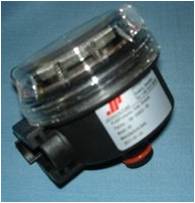The RV fresh water system ensures the RV has clean water for drinking, washing, showering, and toilet flushing. Besides the fresh water tank, covered elsewhere, is the water pump, the hot water heater, the fresh water inlet valve, and all the plumbing associated with hot and cold water. We cover some maintenance issues with the fresh water system on these links to the following pages:
RV Water Pressure Regulators
Water pressure also varies from campground to campground. Some have in excess of one hundred pounds per square inch pressure. Modern rigs are designed for less than fifty. If you do not use a water pressure regulator, you could rupture an interior water hose. Believe me; you do not want to clean up after that, not to mention the expense of a very difficult repair.
Most folks don’t know the difference between pressure and flow, but you should in order to understand the difference. “Flow” is a measure of volume of water delivered in a period of time, usually measured in gallons per minute or gpm. The poor shower is caused by low flow, as are most other RV water supply problems. “Pressure” is a measure of the force of the water, and it is measured when no water is flowing (“static” pressure). It is measured in pounds of pressure per square inch or psi.
RV plumbing systems in an RV Fresh Water System are generally tested to a pressure of 100 to125 pounds per square inch (psi), but to prevent warranty problems, RV manufacturers may recommend only 40-50 psi. Unfortunately, this may not provide the shower you’re looking for. Most house plumbing operates at about 60psi, and this can be adequate for RVs, too.
The cheaper(under $10) pressure regulators are really water flow restricters, and you will notice the restriction when you have to dance around under the shower to get wet. The best way to go is with an adjustable water pressure regulator with a pressure gauge so you know what water pressure is entering your rig. There will be an adjusting screw to raise or lower the pressure. I set ours between 45 and 50 pounds per square inch(PSI.) Get one of these, available at RV parts stores or on-line. You’ll be glad you did.
RV Fresh Water Hoses
The hose you use to connect your RV to the water supply may be the first cause of flow restriction in an RV Fresh Water System. Many RV water hoses are pretty cheap, and they are prone to kinking or collapsing. If your hose does that, you are suffering from a flow restriction. The solution here is to use a better hose that resists deformation. We prefer a 5/8 inch diameter hose instead of the common 1/2 inch. The reason is that 5/8 inch gives you increased flow. Whatever hose you choose, make sure it is designated for potable water use.
RV Fresh Water Pump
Just about every rig with holding tanks has a 12 volt DC electric water pump. It is the heart of the RV Fresh Water System. It pumps water from the fresh water tank to the faucets and shower head. Unfortunately, many manufacturers use inexpensive lower flow and pressure pumps. This produces wimpy showers and just more than a trickle from the faucets. Can this be remedied? I’m glad you asked!
Yes, you can replace that weak sister pump with a more robust higher pressure and higher flow pump available from several manufacturers. Aquatec, SHURflo and Flojet are the big players in the 12 volt water pump market. The trick is to get a pump that will provide the flow and pressure you need.

Aquajet Pump 
Pump Strainer 
Pump Controller
Most RV pumps are SHURflo. They are adequate but most folks complain that they are noisy and irritating, they don’t pump enough water at a high enough pressure, and they cycle constantly during low flow conditions. For a motorhome with 2 sinks and a shower as well as an outside shower, you need plenty of flow and the pressure to get the water to more than one tap at a time.
We use the Aquajet RV model made by Aquatec which provides 5.3 gpm at 65 psi. Aquajet models are direct replacements for SHURflo pumps. The OEM pumps usually draw around 7 amps of power when running. Due to its higher performance, the Aquajet pump draws 10 amps. You must replace the pump controller with a 10 amp model when upgrading to a better pump.
A high flow pump requires a strainer on the inlet side. Small particles can destroy the pump head if they get in the water stream. The wire strainer prevents this.
We have found the RV Water Filter Store http://www.rvwaterfilterstore.com/index.htm to be both a great source of both information and a source of products for RV water issues.
